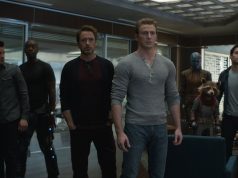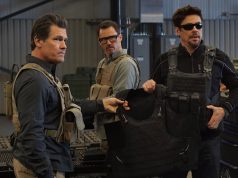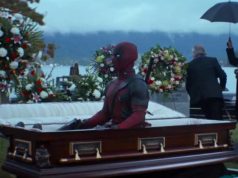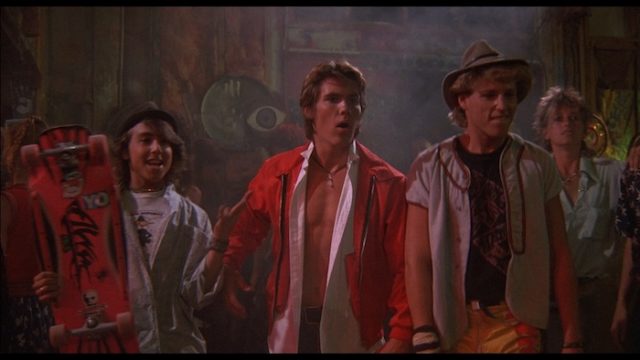
Skateboarding was invented in the 1960s, when surfers got bored with endangering the lives of swimmers and decided to start annoying pedestrians, too. Soon, no matter where you went in California, whether it was a beach or a sidewalk, there would be a constant stream of grinning, shaggy-haired dopes speeding past you on boards, either surf- or skate-, all in a hurry to get to the party at Shawn’s house or the bonfire at Brody’s house or whatever. In the 1980s, when skateboarding became popular in the mainstream again, Hollywood set its phasers on “pander” and cranked out a few skate-themed movies to cash in, though where they thought skateboarders were going to get money to buy tickets, I don’t know.
One of these films was called “Thrashin’,” “thrashing” being what skateboarders called skateboarding when “skateboarding” didn’t sound awesome enough. “Where have you been all day, Chad?” your mother might say, and you’d reply, “Out thrashin’! Get off my back, Mom!” The main character in “Thrashin'” is played by Josh Brolin, but the film’s true star is the act of thrashing (i.e., skateboarding) itself. Approximately 1,382 of the film’s 91 minutes consist of nothing more than teens riding around on skateboards. These teens could be anybody; sometimes they are Josh Brolin.
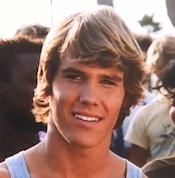
Brolin plays Corey Webster, a kid from the Valley who has made his way over the hills and into one of Southern California’s beach communities in order to participate in a series of thrash-centered competitions. Corey has a cluster of average, slightly dorky fellow-thrashers with whom he associates, one of whom has an RV in his backyard for Corey to stay in while he’s in town. Why doesn’t Corey just crash on the dude’s bedroom floor? Two reasons. One, Corey is going to have sex with a local girl later, and he needs a private venue in which to do it. Two, Corey is so committed to skateboarding that even when he sleeps he needs to be on wheels.

Corey and his buddies do the sort of things teenage skaters tended to do in 1986: they ride skateboards, look at girls, wear loud clothing, ride skateboards, and ride skateboards. They don’t make trouble for anyone, except those persons who do not wish to see teens riding skateboards. The group is bedeviled, however, by a gang of tough guys known as the Daggers, who also ride skateboards. How tough can a gang be when its members’ preferred method of transportation is a plank of wood set on wheels that one must propel with one’s feet, Fred Flintstone-style? Very tough indeed, actually! The Daggers are led by Tommy (Robert Rusler), a dark-haired bully whose eyebrows are too close together, as if they were recently a unibrow and are still undergoing a division, like the Earth just after Pangea. Tommy lets us know right off how tough he is by dissing some breakdancers. Breaking was right up there with thrashing for popular youth activities in the mid-1980s, so Tommy — and, by extension, this film — takes a bold and potentially controversial stance in dissing it. Breaker-thrasher relations have been tense ever since.
Let me mention here that I have no idea how old these people are supposed to be. Some of the actors are clearly no more than 16 or 17, and some unseen parents are occasionally mentioned. But then everybody goes to a club where alcohol is served, and the bouncer doesn’t even check their IDs. Also, Tommy and the Daggers appear to be living communally in a house of their own, which means someone must have a source of income, credit references, and so forth. What I’m saying is that the film’s establishment of a believable context for its narrative is slipshod at best, and that this lessens the story’s dramatic impact vis-a-vis its protagonist.
Anyway, Dagger chieftain Tommy has a blond sister, Chrissy (Pamela Gidley), who is visiting for the summer from their native Indiana. Tommy, Chrissy, and the Daggers go to the aforementioned club one night, as do Corey and his crew, as do all the city’s other thrashing enthusiasts — thrashionados, if you will — for a night of leaping around and punching one another while the Red Hot Chili Peppers perform. (This was in 1986, before the Red Hot Chili Peppers were famous, but even in this early performance you can really get a sense of how tired of them you’d eventually get.) And whose eyes should meet from across the room? Why, the eyes of Corey and Chrissy, of course! They are to be the film’s Romeo and Juliet, albeit with a less satisfying ending.
Now, it isn’t Corey’s affiliation with a rival group of thrashers that makes Tommy disapprove of Chrissy dating him. That would be petty. It’s the fact that Corey is from the Valley, and the Valley is gross and not cool. Tommy grows violently angry at the notion of his sister (who is from Indiana, I remind you) associating with such a person.
Then there are a lot of scenes of Corey and his friends riding skateboards around L.A., going nowhere in particular but getting there in a decidedly thrashtastic manner. This goes on for quite some time.
Also, I just decided that the house where all the Daggers live should be called Thrashtastic Manor.
So then there’s a skateboard competition in an empty swimming pool. It is serious business, with a play-by-play announcer and everything. Corey’s performance is sabotaged when one of the Daggers throws a handful of jacks (the little metal toys from children’s games a thousand years ago) on the cement, throwing him off his board in mid-thrash. The competition officials don’t do anything about this because the jacks are invisible (I guess?), or possibly because the American Thrash League is corrupt and takes its orders from the Daggers.
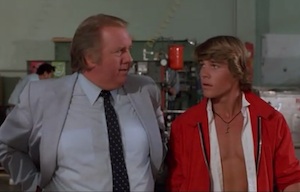
Meanwhile, there is a rotund, middle-aged man named Sam Flood (Chuck McCann) who owns one of the local skateboard manufacturing companies, which he uses as an excuse to spend way too much time hanging around places where young skateboarders congregate, enthusiastically handing out promotional merchandise while standing too close to them. Do I have to spell it out for you? For crying out loud, he even drives a van. Anyway, Corey hopes to win the big competition next week and earn a pro sponsorship from Sam Flood’s Pervy Skateboard Company, though I suspect he could get that sponsorship now if he’d just take off his shirt.
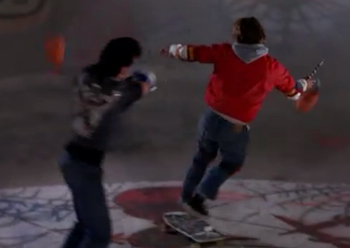
The rivalry between Corey and Tommy finally comes to a head when Tommy challenges him to a joust. Yes, a joust. They meet at night at a dry irrigation canal that can double as a skateboard venue, each armed with what appears to be a medieval-style mace, except at the end of the chain is what appears to be a heart-shaped purse. Then they ride their skateboards toward one another and try to hit each other with these weapons, if indeed a purse on a chain can truly be described as a “weapon.” Also, each jouster’s gang is on hand to cheer him on, and everyone wears face paint and costumes. I don’t mind telling you, the whole thing’s pretty weird. Is it the movie’s contention that gladiatorial contests of this sort were commonplace in the 1980s thrasher community? Or, alternatively, is it merely intended to be symbolic of the type of degradation that can occur when young Californians are unsupervised, a sort of “worst-case scenario”?
In any event, somehow it ends with Corey breaking his arm, and somehow this means he can’t thrash as well as he used to, and now he might lose the big race next week, but then he wins anyway, and Tommy comes to respect him for his prowess and doesn’t care if he has sex with his sister, and everybody goes home happy.
After “Thrashin'” failed to win any Oscars or even a Golden Globe, the brief cycle of skateboard-related films fizzled out. Hollywood went in search of the next big youth activity to exploit, Josh Brolin went on to be a star, and the Red Hot Chili Peppers went on to look like Iggy Pop. It is my understanding that many famous skateboarders have cameos in “Thrashin’,” but because I am elderly, I reject the idea of there being “famous skateboarders,” and so I will not mention them.
— Film.com


